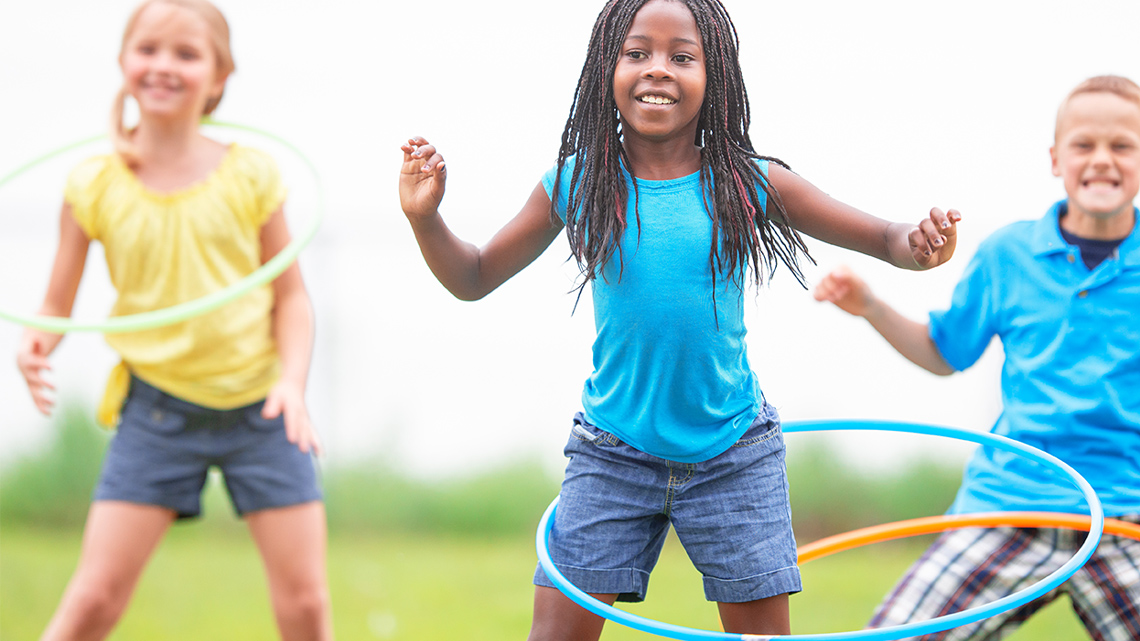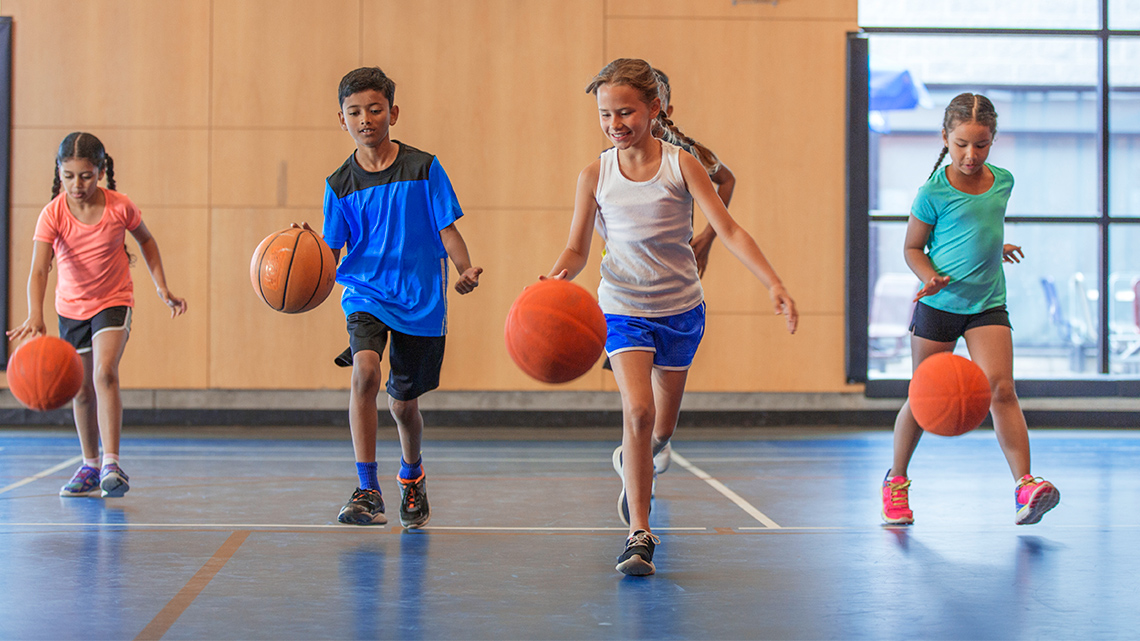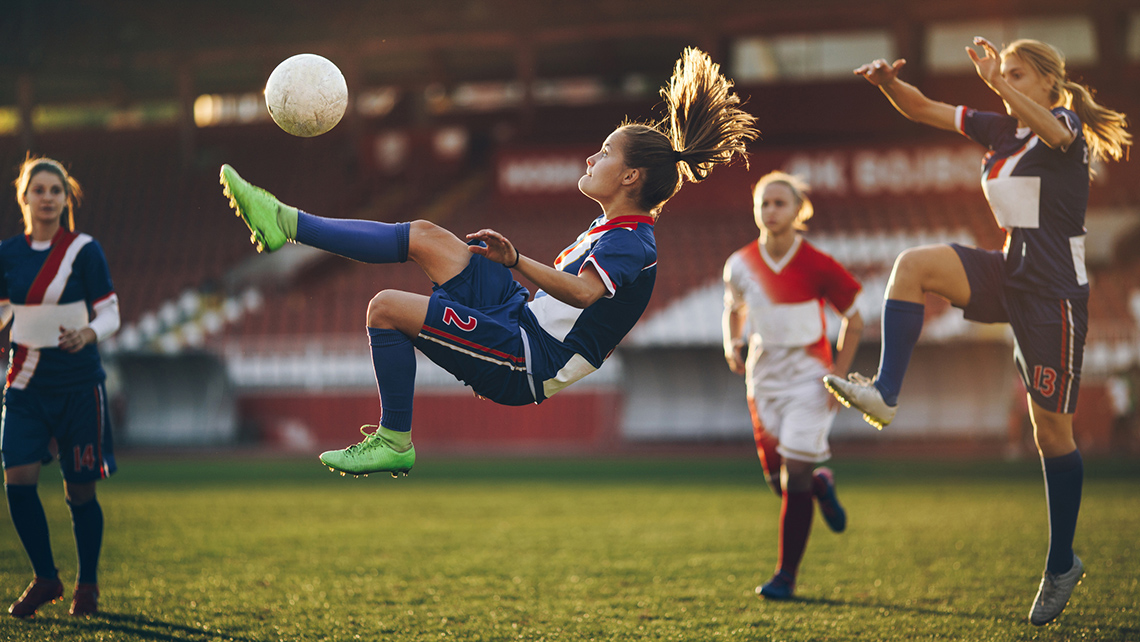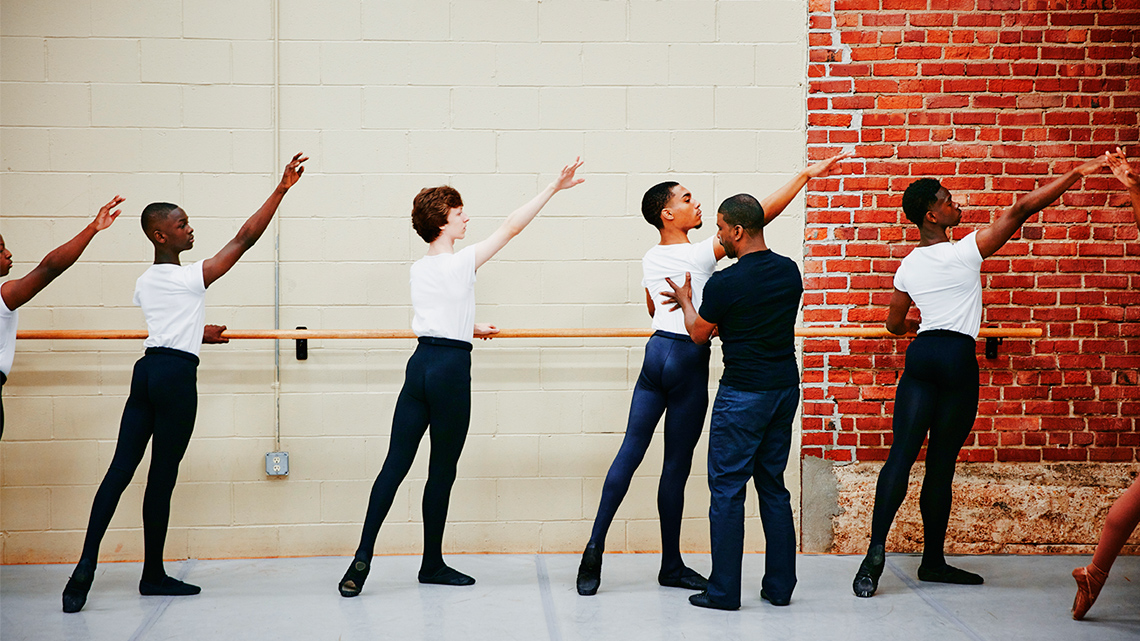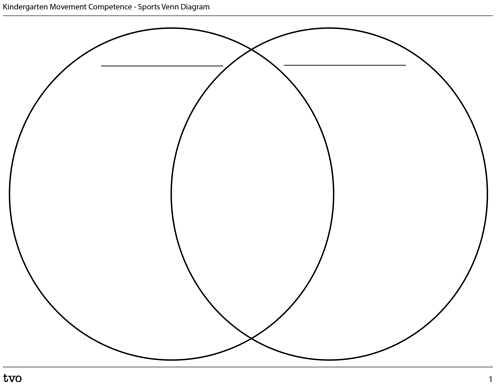Minds On
What’s your sport?
Explore the following carousel for various sports and physical activities.
Think of your favourite sport or physical activity. Now create a one-to-three-minute explanation that describes your favourite sport or activity to someone who is learning about it for the first time. Consider the following questions as you create your explanation:
- What is the equipment and set-up required for this sport?
- How do you play the sport? What are the rules?
- What are some skills and strategies that are important for players in this sport?
- Why is this your favourite sport?
You may share your explanation using a method of your choice. Some possibilities can be a video, audio clip, and written script.
Action
Types of physical activity

There are five main categories of physical activities that sports can fall under:

Five Main Categories of Physical Activities
DescriptionAn infographic of the five main categories of physical activities. The five categories are: target games, net/wall, striking/fielding, territory and individual pursuits. Each category has sample sports and physical activities. Target games include boccia, bowling and golf. Net/wall includes badminton, sitting volleyball, squash, tennis, volleyball and wheelchair tennis. Striking/fielding includes baseball, cricket and softball. Territory includes basketball, goalball, handball, hockey, lacrosse, soccer and wheelchair basketball. Individual pursuits includes athletics, gymnastics and yoga.
Let’s explore each of the five categories of physical activity. For each category there is an activity you may try out to develop a skill that is often used in the category.
Record your learning using the Categories of Physical Activity Chart in your notebook or using the following fillable and printable document. If you would like, you can use speech-to-text or audio recording tools to record your thoughts.
| Category | What is it? What skills are needed? | Examples |
|---|---|---|
| Target | ||
| Wall/Net | ||
| Striking/Fielding | ||
| Territory | ||
| Individual |
Press the ‘Activity’ button to access Categories of Physical Activity Chart.
Before you begin to practise any of the activities, please make sure you complete a safety check and properly warm-up.
Safety
Before you begin, consider these safety precautions:
Warm Up
Warm up
Let’s do a warm up before we get into our main activities! Warm ups will help you better perform a movement/activity while also greatly reducing your chance of injury.
Depending on what activities you are performing, choose one of the following warm ups, or you may do a combination of them.
Press the following tabs to access the warm ups.

- Jogging: Let’s start off with a relaxed jog for 5 minutes. You can jog in one place or back and forth in your space.
- Jumping jacks: Now do 10 jumping jacks! To perform a jumping jack, position your body straight up with hands to your sides. Then jump and spread legs apart and bring arms above the head. After that, jump back into starting position.
- Toe touch: Time to touch our toes! Have your body straight up. Then lean and bend forward and try your best to touch your toes. Hold the position for 10-20 seconds, return to straight upward position and repeat 10 times.
- Sit-up: Now do 10 sit-ups! To set-up a sit-up, lay on your back and bend your knees to form a ‘V’ shape with your legs. Bend your upper body towards your knees to perform the sit-up.
- Mountain climber: Finally, do the mountain climber for 60 seconds. To perform the mountain climber set yourself up in the push up position, then bring each knee forward as if you were climbing.

- Neck Tilts and Rotations: Slowly tilt your head side to side 10 times and then slowly and carefully rotate your neck 10 times in each direction.
- Arm Circles: Straighten your body and put your arms straight out to the sides. Then start forming circles in one direction, start with small circles and work your way up to large circles. Do this 10 times and then repeat with the opposite direction.
- Chest Expansions: Straighten your body and put your arms out straight to the sides with palms of hand facing forward. Bring your hands together in a clapping motion slowly, then return to the starting position. Do this 10 times.
- Wrist Circles: Clasp your wrists together and start to circle your wrists in one direction. Do this 10 times and then repeat with the opposite direction.
- Shoulder Rolls: Put your arms to the side keeping your posture straight. Rotate your shoulders forward to make a circle. Do this 10 times and then repeat with the opposite direction.

- High Knee Jog: Standing straight with shoulder-width apart perform a jog but raise your knees to about waist level. Do this for two minutes.
- Side-to-Side Hops: Standing straight with hands to side and feet hip-width apart hop side to side quickly. Do this for two minutes.
- Lunges: Stand straight with feet hip-width apart and arms grabbing the side of your hips. Take a step forward and bend your knees so that you form two 90-degree angles with your legs with one leg forward and one leg behind. Hold the position for 20-30 seconds then switch legs and repeat. Do this three times.
- Squat Side Kick: Go into a squat position so that your feet are shoulder-width apart and your hips are back. Then gradually get up and shift your weight towards one leg so that you can lift your other leg out to the side in a slow kick motion. Then return to the squatting position. Do this 10 times for each leg.
- Lateral Leg Swing: Stand upright, holding onto a wall with one hand for support and the other hand placed on the side of your hip. Swing one leg in front carefully across your body from side to side for 10 times. Then repeat with other leg.
Target activities
Press the following tabs to access and explore what a target activity is.
Target activities are ones where players are aiming for a specific target. Target activities can also include avoiding obstacles while aiming. Target activities need focus, aim, accuracy, and precision. Players that become good at target games learn how to control the speed and trajectory by applying the right amount of force to the object. Players have to consider the environment and situation when choosing how much force they should use to hit their target.
Examples of target activities include archery, bowling, croquet, golf, and curling.

Target Activities
Let’s do some target practice with a bean bag toss activity. Bean bag toss is also known as cornhole. Bean bag toss is a popular lawn game where players throw bean bags at a specific target. The target is usually a hole in a raised platform. Each time a player gets a bean bag in the hole they get three points. If the bean bag misses the hole but lands on the raised platform it is one point. The first player that gets to 21 points wins. Let’s explore the following modified version that uses household items.
Equipment
The following equipment is required for this activity:
- Bean bags. You can try using balls, rolling socks into balls, crumpling paper into balls, or making your own bean bags. To make your own bean bag, you will need some fabric and something like rice to stuff the fabric with. You can glue the fabric or stitch it to make the bean bag.
- Find something that can be used as target(s) such as paper cups, bottles, hula hoops, t-shirts, cloth, or you could draw a target on the ground with chalk.
How to play
Set up your target. You can have one target or many targets at varying distances. If you have more than one target, you can increase the point values for targets that are further.
Then select a distance that is away from the target to throw/kick from. Choose a distance that is slightly challenging for you to throw/kick from.
Aim and throw/kick your bean bags at the target until you reach 21 points.
If you have a partner, you can compete with them and see who gets 21 points first!

Playing Bean Bag Toss
Net/wall activities
Press the following tabs to access and explore what a net/wall activity is.
Net/wall activities are ones where players are attempting to send an object towards a target area where an opponent is defending. Players aim to send the object in the target area while making it hard for the opponent to return the object. Players of net/wall activities need to practise their spatial awareness, positioning, and anticipation to send and receive the object. Players have to consider their agility, speed, timing, and teamwork.
Examples of net/wall activities include tennis, volleyball, pickleball, and badminton.

Net/Wall Activities
Being able to send and receive objects effectively is the key to net/wall activities. Let’s practise our skills with wallball. Wallball is a sport where you are hitting a ball off the wall with your hands.
Equipment and set-up
Explore the following equipment and set up required for this activity.
- A small ball such as a tennis ball or rubber ball.
- Find an area with a flat smooth wall that is safe to throw a ball at.
- If you can mark the boundaries of the playing field, some items you may use to mark these boundaries are chalk, tape and pylons. The boundary should be 6 metres wide by 12 metres long. The serve line is about 1.5 metres from the wall. You may adjust these boundaries depending on your comfort level.
How to play
You will serve the ball approximately 1.5 metres away from the wall (at the serve line). You can serve with your hands or feet.
When serving the ball, it must bounce on the ground one time before hitting the wall.
Then when you are receiving the ball you must let it bounce on the ground once after it hit the wall before returning the ball towards the wall.
The ball is still in play until it either bounces out of bounds, hits the wall without bouncing on the ground, bounces more than once before returning the ball or is not bounced once before sending the ball back to the wall.
If you have a partner or some friends, you can take turns sending and receiving the ball. Keep track of who can keep the ball in play the longest!

Playing Wallball
Striking/fielding activities
Press the following tabs to access and explore what a striking/fielding activity is.
Striking/fielding activities are ones where players are striking objects to score points. The opponents are retrieving and returning the object to stop play and prevent scoring, which is known as fielding. Players need to practise how to control the speed and trajectory by applying the right amount of force to the object. A player striking the object also should consider the environment and situation. Striking players also need to be able to anticipate the sending and receiving of the object, similarly to net/wall activities. Fielding players need to have good communication and cooperation with their teammates, as well as focus and anticipation of the object to retain it.
Examples of striking/fielding activities include baseball, cricket, kickball, and softball.

Fielding/Striking Activities
Being able to strike an object effectively is key to scoring in striking/fielding activities. Let’s batter up and practise this skill with this activity.
Equipment and set-up
Check out the following equipment and set up required for this activity:
- Small ball(s) such as a softball, baseball, or tennis ball. You could also crumple paper into a ball or roll a sock into a ball.
- A bat (optional).
- Pylons, cones, bottles, or objects that can hold the ball in place and be used to mark target area locations. The object that is holding the ball should ideally hold the ball in place at a height where you can swing your arms/bat at easily.
How to play
- Place the ball on top of the object.
- Swing and strike the ball with your hand or a bat aiming at the target area location you set. You may also choose to kick the ball at the target.
- To challenge yourself or friends you may want to measure how many balls you can get in a target area in a certain amount of time or attempts.

Playing Baseball
Territory activities
Press the following tabs to access and explore what a territory activity is.
Territory activities are ones where players are trying to control an object, keep it away from opponents and move the object into a specific target area to score. Unlike a wall/net activity, in territory activities, all the players are in the same playing area. Players need to effectively communicate and cooperate with teammates.
Examples include soccer, basketball, ultimate frisbee, football, and hockey.

Territory Activities
Keeping possession of the object is important in any territory activity. The following activity is a drill you can use to practise keeping possession of a ball.
Equipment & set-up
- Any ball that is safe for you to kick or bounce around
- Timer/stopwatch
- 2 pylons, cones, plastic/paper cups or bottles to be used as objects to avoid. Place the 2 objects approximately 5 metres apart from each other.
How to play
- Choose whether or not to dribble with your hands or feet.
- Dribble around the two objects to form figure eights. Tip: Start off dribbling slowly so you can learn to maintain control of the ball.
- You can measure how many figure eights you can do given a certain time frame or use a stopwatch and measure how much time it takes to do a specific number of figure eights.

Figure Eight Dribbling Drill
Individual activities
Press the following tabs to access and explore what an individual activity is.
Individual activities are ones where participants can do the activity on their own. This can involve a variety of skillsets depending on the exact sport.
Examples include yoga, running, swimming, dancing, gymnastics, and cycling.

Individual Activities
Think of an individual activity you have done before. Take 5-15 minutes to practise/perform that activity. This can include running laps, freestyle dancing, and Pilates.
Cool Down
Cool down
Now it’s time for a cool down! It’s important to allow your body to gradually return to a resting state after intense physical activity.
Remember to perform your safety check before you begin.
Depending on what activities you are performing, choose one of the following cool downs, or you may do a combination of them.
Press the following tabs to access the cool downs.

- Jogging: Begin with a jog and transition to a walk. Do this for 2-5 minutes.
- Wide Toe Touch: Now do wide toe touches for 60 seconds. To perform a wide toe touch, position your body in the shape of a star, then bend forward and reach with one arm to touch the opposite foot. The other arm which is on the same side as the foot is pointed upwards. Hold this position for 10-15 seconds, then return to the starting position and repeat on the opposite side.
- Quad Stretch: Stand up straight and shift your weight to one leg. Then lift your other leg backwards towards your butt and grab it with the arm on the same side. Hold it for 20-30 seconds and repeat with the other leg. Do this 5 times for each leg.
- Child’s Pose: Do the child pose for 30 seconds. To perform the child pose, get down on your knees and bend your body forwards stretching your arms out. Your forehead should be resting on the floor.
- Abdominal Stretch: Now, do an abdominal stretch for 30 seconds. To perform the abdominal stretch, lie face down with legs straight up and place your arms in a push up position. Push upwards and slowly lift your torso holding the position.

- Shoulder Stretch: Bring one arm across your chest bend your other arm to help support it into position. Hold the position for 30 seconds and then do the opposite side. Repeat three times.
- Triceps Stretch: Bend one arm up and behind towards your shoulder blade. Use the other arm to help support it into position. Hold the position for 30 seconds and then do the opposite side. Repeat three times.
- Overhead Stretch: With your body straight interlock your fingers and bring your arms above your head. Have your palms facing away from you. Hold the position for 60 seconds.
- Torso Stretch: With your body straight fold one arm behind your back and use the other arm to help support it into position. Then bend your torso towards one side. Hold the position for 30 seconds and then do the opposite side. Repeat three times.
- Chest-Cross Arm Swing: With your body straight put your hands horizontally straight out to the sides and then swing your arms to make an ‘X’ shape back and forth for 60 seconds.

- Flutter Kick: Lie on your back with your hands to the side. Lift your legs and perform a kicking motion, alternating the legs back and forth. Do this for one minute.
- Side-Lying Leg Lifts: Lie on your side with one arm supporting your head and one arm bend in front supporting your body in position pushing against the ground. Lift your leg slowly and gradually return it back. Do this five times and then switch to the other leg.
- Single Leg Hug: You can do this lying on your back or standing straight up. With your arms hug your thigh to bring one knee towards your chest. Hold the position for 20-30 seconds then gradually release and switch sides. Repeat three times.
- Butterfly Stretch: Sitting on the floor bring both feet together so they are touching. Use your arms to safely move your knees towards the floor. Hold the position for 20-30 seconds and then release gradually. Repeat three times.
- Hip Flexor Stretch: Kneel on one of your knees and bend your other leg in front of your body at approximately a 90-degree angle. Shift your weight forward until you feel a stretch. Hold the position for 20-30 seconds and switch sides. Repeat three times.
Consolidation
Match up!
For each sport, select the corresponding category of physical activity.
Compare and contrast

Comparing and Contrasting Sports
Now let’s compare and contrast two sports from two different categories that you learned about. Consider the following questions to help guide your thinking:
- What category of physical activity are your chosen sports?
- What kinds of skills, strategies and tactics are needed and developed while playing each sport?
- What are the similarities and/or differences in equipment, setup, and gameplay?
Complete the Sports Venn Diagram in your notebook or using the following fillable and printable document. If you would like, you can use speech-to-text or audio recording tools to record your thoughts.
Fill in the Venn diagram to identify the characteristics of one sport in one circle, the characteristics of the other sport in the other circle, and the common characteristics between these two sports in the overlapping area.
Reflection
As you read the following descriptions, select the one that best describes your current understanding of the learning in this activity. Press the corresponding button once you have made your choice.
I feel…
Now, expand on your ideas by recording your thoughts using a voice recorder, speech-to-text, or writing tool.
When you review your notes on this learning activity later, reflect on whether you would select a different description based on your further review of the material in this learning activity.
